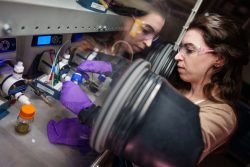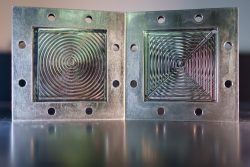Albuquerque, NM (KKOB) — Most Americans don’t leave home without at least one lithium battery-powered device, and someday, the house itself may have a battery back-up.

Sandia National Laboratories battery expert Melissa Meyerson works in a glovebox to setup a lithium-sulfur flow battery. These kinds of batteries have huge potential for being large, safe and in-expensive back-ups for a high-renewables grid. (Photo by Craig Fritz) Click on the thumbnail for a high-resolution image.
Scientists at Sandia National Laboratories are working to make these large back-up batteries less expensive, hold more energy and be less prone to bursting into flame. One way to tackle all three challenges is by changing up the battery chemistry with the addition of sulfur, according to Sandia battery expert Melissa Meyerson.
“One of the biggest benefits compared to what is on the market today is the energy density,” Meyerson said. “Lithium and sulfur are two of the most energy-dense materials for batteries, and sulfur is incredibly cheap.”
A partnership between technical experts at Sandia and local entrepreneurs facilitated by the Department of Energy’s Boost program aims to get big, safe, stationary lithium-sulfur flow batteries to market faster.
The flow battery design allows for a physical separation of the portions of a household battery labeled with a minus and plus sign. This separation should make the battery safer and less likely to lose charge when just sitting idle, said Leo Small, a Sandia materials scientist who is also part of the collaboration.
“One goal is to make grid-scale batteries: really, really big batteries,” Small said. “One of the objectives we were trying to go after by putting the lithium sulfur chemistry into a flow battery architecture was to physically separate the anode and the cathode to potentially make it safer when dealing with thousands or millions of kilowatt-hours of energy storage.”
One thousand kilowatt-hours is enough to power approximately 33 U.S. households for a day.
Building better battery technology
The team’s largest technical hurdle was adapting lithium-sulfur chemistry into a flow battery design, Meyerson said.
The current lab-scale battery, about three inches wide, consists of a solid lithium metal anode, representing the minus sign side of a household battery, and a liquid cathode, representing the plus sign side. When the battery provides electricity, the lithium metal becomes lithium ions. The other side of the battery comprises a complex cathode-organic electrolyte with lithium salt and sulfur bits mixed in, Meyerson said. On that side, the lithium salt and sulfur become lithium sulfide when the battery provides electricity. Both sides of the battery contain other chemicals that help charging and discharging reactions take place. A pump moves around the electrolyte and these helper-chemicals to restore them to their active form.

The interior of a lithium-sulfur flow battery being designed at Sandia National Laboratories. A partnership between technical experts at Sandia and local entrepreneurs aims to get these batteries to market faster. (Photo by Craig Fritz) Click on the thumbnail for a high-resolution image.
As part of the research project, the team developed a new design for the lithium metal anode, allowing the battery to recharge faster, Meyerson added. There is still more work to be done to refine the complex cathode-organic electrolyte mixture to improve performance while possibly reducing costs, she said.
The team also wants to increase the battery’s capacity to store energy by increasing the amount of lithium or sulfur it contains, Small said. Additionally, the team’s entrepreneur-partner is interested in a lab-scale prototype with several cells in series to make a 12-volt battery, he added.
“The things that we’re focused on as scientists aren’t necessarily the priorities of entrepreneurs,” Small said. “They might say, ‘Actually, this thing is driving the cost, so if you could get rid of it, that would be helpful.’ This perspective can help reframe our research and what we should be looking at for increasing the technology readiness level.”
Boosting local entrepreneurship
New Mexico entrepreneur Charles Call was working on a startup company to develop a solar-powered device for producing water from air. He realized that the company needed a reliable battery, capable of storing energy for long periods, allowing continuous water production when the sun wasn’t shining.
Enter the brand-new DOE Boost program.
The DOE Boost program, a collaboration between FedTech, a startup accelerator company, and Sandia, consists of a 16-week boot camp with weekly seminars and coaching sessions by FedTech to help entrepreneurs with their startup companies.
“I have 25 years of experience building startup companies,” Call said. “I went into the program thinking I could probably teach all of these classes, but I learned something new every week. I give a lot of credit to the DOE Boost program for the quality of the sessions and mentors.”
Selected entrepreneurs are paired with Sandia technical experts for technical guidance and discussions during weekly calls. Call’s interest in advanced battery technology led to his pairing with Small and Meyerson.
Midway through the program, there is a practice pitching session, and the program culminates in a pitch session where the winning entrepreneur receives $2,000 towards launching their company and additional technical guidance. Call described the pitching contest as a fun way to encourage entrepreneurs to focus their efforts on preparing their business plan in the face of a hard deadline.
Forging ahead together
Currently, Call is applying for grants and other funding opportunities to continue the partnership, frame the research, and advance the technology’s transition from the research and development stage to the field-demonstration stage as quickly as possible, he said. GridFlow, the startup company, is working on licensing Sandia’s provisional patent to aid them in the funding applications, Small said.
By this fall, Call aims to show the commercial viability of the technology and have a 100-watt or a kilowatt prototype ready for field or home testing.
“I feel we have an almost too-good-to-be-true partnership here,” Call said. “No one on my team is a battery expert, and we’re not ever going to be great chemists like they are, but we have experience in startups, finance, technology and product development. We especially have a lot of experience building products that have fluidics, and the flow aspect of this technology was the part of the system the scientists were least familiar with.”
The battery research is funded by DOE’s Office of Electricity, while the collaboration was supported by DOE Boost, funded by DOE’s Technology Commercialization Fund and administered by the Office of Technology Transitions.





